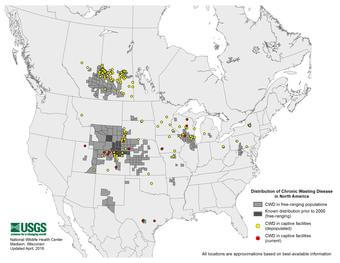Chronic wasting disease may have long-term negative effects on white-tailed deer, a highly visible and economically valuable keystone species, according to a new study from the USGS and published in Ecology.
CWD is an always-fatal, neurological disease of the deer family, scientifically referred to as cervids that include white-tailed deer, mule deer, elk and moose. The disease is an internationally-significant wildlife management issue for free-ranging and captive white-tailed deer. Originally described in captive mule deer about 35 years ago in Colorado, CWD has now been discovered in 24 states, two Canadian provinces, the Republic of Korea and Norway.
“Despite the health threat of CWD to deer populations, little is known about the rates of infection and mortality caused by this disease,” said Dr. Michael D. Samuel, USGS wildlife biologist and lead author on the report.
Researchers used mathematical models to estimate infection and mortality for white-tailed deer in Wisconsin and Illinois outbreaks. They found that adult male deer have three times the risk of CWD infection than female deer and males also have higher disease mortality than females.
“Additional research is needed to more fully understand how CWD is transmitted to healthy deer and the potential long-term impact of the disease on North American deer populations,” said Samuel. USGS scientists found that CWD-associated deaths can cause substantial reductions in deer populations in areas where CWD is not addressed.
Scientific understanding of the ecology and transmission of CWD in free-ranging wildlife is limited, but this information is critical for making management decisions and helping to better understand the ecology of CWD in free-ranging populations.
The paper, “Chronic wasting disease in white-tailed deer: infection, mortality, and implications for heterogeneous transmission,” was published in Ecology and authored by Michael D. Samuel, USGS, Wisconsin Cooperative Wildlife Research Unit, University of Wisconsin; Daniel Storm, Department of Forest and Wildlife Ecology, University of Wisconsin, and currently with the Wisconsin Department of Natural Resources.


